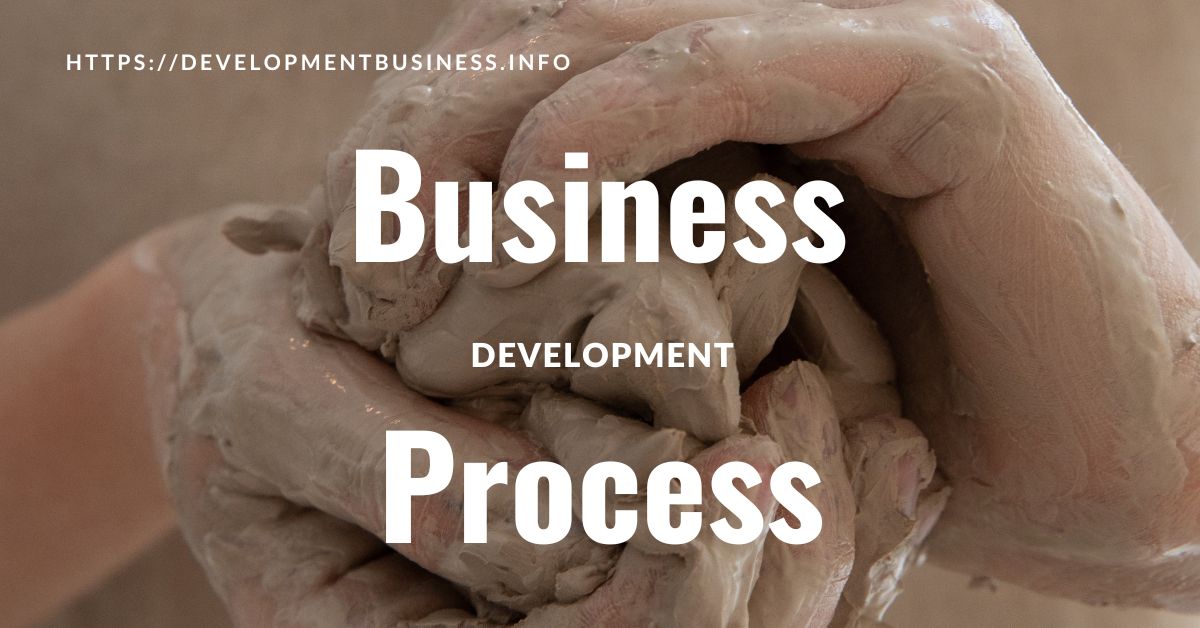Introduction to The Ins and Outs of Business Development – A Comprehensive Guide

As someone who has witnessed firsthand the power of effective business development, I am thrilled to share this comprehensive guide with you. Business development plays a crucial role in driving growth and success for organizations of all sizes and industries. In this blog post, we will explore the definition of business development, its significance within organizations, and provide valuable insights into its various aspects. So, let’s dive in and uncover the secrets of successful business development!
Understanding Business Development
Business development encompasses a wide range of activities aimed at identifying and creating growth opportunities for a company. It involves building and nurturing relationships, exploring new markets, and optimizing existing processes. To grasp the true essence of business development, let’s break it down further:
Definition and Scope of Business Development

Business development involves strategic planning and implementation of initiatives to fuel business growth. It goes beyond mere sales and marketing and focuses on long-term value creation. By understanding the core principles of business development, companies can unlock new opportunities and propel themselves ahead of the competition.
Key Objectives and Goals of Business Development
The primary objectives of business development include expanding market share, increasing revenue, diversifying product offerings, and establishing strategic partnerships. By setting clear goals and aligning them with the overall business strategy, organizations can achieve sustainable growth and profitability.
The Role of Business Development in Overall Business Strategy
Business development serves as a crucial component of an organization’s overall strategy. It acts as the catalyst that drives innovation, helps identify emerging trends, and positions the company for long-term success. By integrating business development into the fabric of an organization, companies can adapt to changing market conditions and seize new opportunities effectively.
Common Misconceptions about Business Development
There are a few misconceptions surrounding business development that need to be addressed. Contrary to popular belief, business development is not limited to sales and marketing; it encompasses a much broader spectrum of activities. Additionally, business development is not a one-time effort but an ongoing process that requires dedication, strategic thinking, and adaptability.
Key Skills and Qualities for Business Development Professionals
Successful business development professionals possess a unique blend of skills and qualities. Let’s explore some of the most crucial ones:
Analytical and Strategic Thinking Skills
Business development professionals must possess strong analytical skills to identify trends, evaluate market potential, and make data-driven decisions. Additionally, strategic thinking allows them to develop innovative approaches and create actionable plans for business growth.
Strong Communication and Interpersonal Skills
Effective communication is at the heart of business development. Professionals in this field must be able to convey their ideas clearly, build rapport with clients and stakeholders, and negotiate win-win deals. By fostering strong interpersonal relationships, business development professionals can open doors to new opportunities and partnerships.
Sales and Negotiation Abilities
While business development goes beyond sales, having a solid understanding of the sales process and negotiation techniques is crucial. Business development professionals must be skilled in identifying prospects, cultivating leads, and closing deals that benefit all parties involved.
Business Acumen and Market Awareness
To drive growth, business development professionals need to have a deep understanding of their industry, market dynamics, and competitive landscape. By staying abreast of industry trends and market shifts, they can make informed decisions and position their companies advantageously.
Relationship Building and Networking Capabilities
Business development thrives on building and nurturing relationships. Professionals in this field must be adept at networking, forging connections, and maintaining long-term partnerships. By leveraging their networks, they can tap into new opportunities and gain valuable insights.
Adaptability and Resilience
Business development is an ever-evolving field, and professionals must be adaptable to changing market dynamics. They need to be resilient in the face of challenges and setbacks, maintaining a positive mindset and persevering to achieve their goals. The ability to adapt strategies and approaches based on feedback and market shifts is key to successful business development.
The Business Development Process

Now that we have a solid foundation of understanding business development, let’s delve into the step-by-step process of driving growth and seizing opportunities:
Identifying and Evaluating Opportunities
Business development begins with identifying potential opportunities for growth. This involves conducting thorough market research and analysis to understand customer needs, industry trends, and competitive landscapes. By evaluating these opportunities, businesses can determine their viability and alignment with their overall objectives.
Developing a Business Development Strategy
With a clear understanding of potential opportunities, it’s time to develop a robust business development strategy. This includes setting specific goals and objectives, creating a strategic plan, and allocating necessary resources. Defining key metrics and performance indicators ensures that progress can be measured effectively.
Implementing the Strategy
The success of a business development strategy lies in its execution. Implementation involves building strategic partnerships and alliances, developing and executing targeted marketing campaigns, and managing the sales process. By leveraging effective communication and collaboration across departments, organizations can maximize their chances of success.
Evaluating and Refining the Approach
Continuous evaluation and refinement are vital for the long-term success of business development efforts. Monitoring and measuring performance against set metrics allows businesses to assess the effectiveness of their strategies. Collecting customer feedback and incorporating it into decision-making helps in adapting and improving the approach over time.
Effective Business Development Techniques
Now, let’s explore some proven techniques that drive successful business development:
Networking and Relationship Building
Networking is a powerful tool in business development. Attending industry events, conferences, and seminars provides opportunities to connect with potential partners, clients, and industry influencers. Building and nurturing relationships through regular communication and collaboration fosters trust and opens doors for future collaborations.
Cold Calling and Prospecting
While technology has transformed the business landscape, traditional techniques like cold calling remain effective. Identifying potential leads, conducting targeted outreach, and engaging in meaningful conversations can uncover new opportunities and generate leads.
Attending Industry Conferences and Events
Industry conferences and events offer valuable networking opportunities and provide a platform to showcase expertise. By participating as a speaker or panelist, businesses can position themselves as thought leaders and attract attention from key industry players.
Content Marketing and Thought Leadership
Creating high-quality content that addresses customer pain points and provides valuable insights establishes businesses as thought leaders in their respective fields. Sharing expertise through blog posts, articles, and social media content helps build credibility and attract potential clients.
Leveraging Technology and Data Analytics
Technology plays a crucial role in business development. Tools and platforms for customer relationship management (CRM), data analytics, and market research provide valuable insights and help optimize decision-making. Leveraging technology enables businesses to streamline processes, enhance efficiency, and identify new opportunities.
Collaborating with Other Departments
Business development is a team effort that requires collaboration with other departments, such as marketing and sales. Aligning strategies and sharing information fosters synergy and creates a unified approach towards achieving growth objectives.
Challenges and Best Practices in Business Development
While business development offers tremendous opportunities, it also comes with challenges. Let’s explore some common obstacles and best practices to overcome them:
Overcoming Common Obstacles and Roadblocks
Business development professionals often face challenges such as intense competition, market saturation, and changing customer preferences. By staying agile, staying updated on industry trends, and embracing innovation, businesses can navigate these obstacles and adapt to changing circumstances.
Strategies for Successful Business Development
To ensure successful business development, it’s crucial to establish a clear vision, set realistic goals, and align strategies with the overall business objectives. Embracing a customer-centric approach, fostering a culture of innovation, and investing in continuous learning and development are key strategies for sustainable growth.
Building a Strong Business Development Team
Having the right talent and team structure is vital for effective business development. Hiring professionals with diverse skill sets, fostering a collaborative environment, and providing ongoing training and mentorship contribute to building a high-performing business development team.
Creating a Culture of Innovation and Entrepreneurship
Encouraging a culture of innovation and entrepreneurship within the organization fosters creativity and agility. Embracing new ideas, promoting calculated risk-taking, and rewarding innovation create an environment that nurtures business development and drives growth.
Measuring and Reporting on Business Development Success
Measuring the effectiveness of business development efforts is crucial to track progress and make data-driven decisions. Establishing key performance indicators (KPIs), tracking metrics, and implementing regular reporting mechanisms provide valuable insights and enable organizations to make informed adjustments to their strategies.
Case Studies and Success Stories from Real-World Businesses
Learning from real-world examples can provide inspiration and practical insights. Case studies and success stories that showcase how businesses have achieved growth through effective business development strategies offer valuable lessons and guidance for implementing similar approaches.
Conclusion
In conclusion, business development plays a pivotal role in driving growth and success for organizations. By understanding the fundamentals of business development, developing key skills and qualities, following a well-defined process, and employing effective techniques, businesses can unlock new opportunities and propel themselves ahead in a competitive market. While challenges exist, adopting best practices, fostering innovation, and embracing collaboration position organizations for long-term success. By investing in business development and staying adaptable to changing market dynamics, businesses can achieve sustainable growth and thrive in the ever-evolving business landscape.
FAQs About Business Development
Q1: What is the difference between business development and sales?
A: While sales focuses on closing deals and generating revenue, business development encompasses a broader range of activities. Business development involves identifying growth opportunities, establishing partnerships, conducting market research, and developing strategies for long-term value creation. Sales is a part of the business development process but not its sole focus.
Q2: How can business development benefit small businesses?
A: Business development is equally relevant for small businesses. It enables them to identify and tap into new markets, establish strategic partnerships, and differentiate themselves from competitors. By leveraging effective business development techniques, small businesses can achieve growth, expand their customer base, and enhance profitability.
Q3: Is business development only relevant to B2B companies?
A: No, business development applies to both B2B and B2C companies. While the approaches and strategies may differ, the core principles of identifying growth opportunities, building relationships, and driving value creation are applicable to businesses across various industries and sectors.
Q4: How can technology support business development efforts?
A: Technology plays a crucial role in business development. CRM systems help manage customer relationships and track interactions, while data analytics tools provide valuable insights into customer behavior and market trends. Additionally, digital marketing platforms and automation tools streamline marketing campaigns and lead generation efforts, enhancing overall business development effectiveness.
Q5: How long does it take to see results from business development efforts?
A: The timeline for seeing results from business development efforts can vary depending on various factors, such as the industry, market conditions, and the specific strategies implemented. In some cases, businesses may start seeing immediate results through successful lead generation or partnership opportunities. However, the full impact of business development initiatives often takes time to materialize. It requires consistent effort, relationship building, and strategic execution. Patience and a long-term perspective are crucial in evaluating the success of business development efforts.
Q6: How can businesses measure the success of their business development efforts?
A: Measuring the success of business development efforts involves defining key performance indicators (KPIs) and tracking relevant metrics. These can include metrics such as revenue growth, market share expansion, partnership acquisition, customer acquisition, or customer satisfaction. Regular monitoring and analysis of these metrics provide insights into the effectiveness of strategies and allow businesses to make data-driven decisions to optimize their business development approach.
Q7: What are some emerging trends in business development?
A: Some emerging trends in business development include the increasing importance of digital transformation, leveraging artificial intelligence (AI) and machine learning for data analysis and decision-making, and the growing focus on customer experience and personalization. Additionally, the rise of remote work and virtual collaboration has impacted how business development professionals build relationships and network. Staying updated on these trends and embracing new technologies can give businesses a competitive edge in their business development efforts.
Q8: Can business development benefit established companies as well?
A: Absolutely! Business development is not limited to startups or small businesses. Established companies can benefit from business development by exploring new markets, diversifying their product offerings, optimizing existing processes, and forging strategic partnerships. It helps them stay competitive, adapt to changing market conditions, and drive sustainable growth.
Q9: How often should a business review and adjust its business development strategy?
A: Regular review and adjustment of the business development strategy are crucial to stay relevant and effective. It’s recommended to conduct periodic assessments, at least annually, to evaluate the performance of the strategy, reassess goals, and make necessary adjustments based on market trends and evolving business objectives. Flexibility and adaptability are key to ensuring the business development strategy remains aligned with the changing business landscape.
Q10: Is business development a one-time effort or an ongoing process?
A: Business development is an ongoing process rather than a one-time effort. It requires consistent attention, proactive efforts, and continuous improvement. Business environments are dynamic, and customer needs evolve over time. Therefore, businesses need to continually identify new opportunities, build relationships, and refine their strategies to stay competitive and foster sustainable growth.
In conclusion, business development is a dynamic and multifaceted field that plays a pivotal role in driving growth and success for organizations. By understanding its fundamental principles, developing key skills, and implementing effective strategies and techniques, businesses can unlock new opportunities, build valuable partnerships, and position themselves for long-term success. Continual adaptation, innovation, and measurement of success are essential to thrive in today’s competitive business landscape. Embrace the ins and outs of business development and unlock the potential for sustainable growth and success.
Follow Business Development Facebook Page
Find Out How You Should Start Harnessing the Power of Social Media for Business Success.
